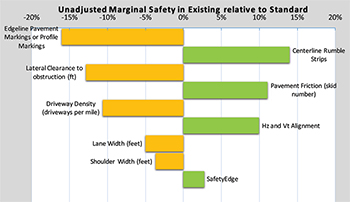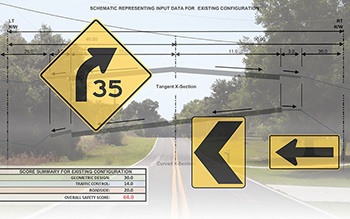MEASURE TWICE, CUT ONCE — that’s the old carpenter’s adage aimed at improving quality and reducing error. A new tool created by researchers at the Texas A&M Transportation Institute (TTI) can help engineers achieve similar efficiencies when designing roadways while saving lives and reducing injuries.
Typically, roadway designs are largely dictated by engineering decisions driven by established standards. For example, what slope angle should the curve include, or where should the signage be placed to alert drivers the curve is ahead? Once the road is constructed, safety data can help engineers better understand how past engineering decisions and driver behavior sometimes resulted in crashes. Adjustments can then be made to improve safety. But what if roadway safety could be maximized before those crashes occur?
TTI created the Safety Assessment Methodology and Tool to help designers understand how interventions can affect the safety of roadway design before construction even occurs. Each countermeasure’s safety effectiveness is scored using crash modification factors (CMFs) for each roadway feature in a new design. According to the Federal Highway Administration, a CMF is used “to compute the expected number of crashes after implementing a countermeasure on a road or intersection.” In designing this new tool, TTI researchers used Texas-specific CMFs, when available, or factors developed from safety studies conducted across the country and catalogued at the CMF Clearinghouse. The project was sponsored by the Texas Department of Transportation (TxDOT) as part of its new initiative to maximize the overall safety of roadways statewide.
“The scoring tool is intended to be used by designers as early as project scoping and through the design process to take a hard look at what can be done to make a project safer,” explains Jessica Butler, deputy director of TxDOT’s Design Division. “Availability and use of the tool can help drive dialogue and support design decisions that enhance the safety of the roadway.”
Generally speaking, traditional design looks at existing conditions (geography, weather, etc.) where a roadway is proposed and then applies accepted design standards to construct it. The methodology behind the tool works within that framework while providing safety-enhancement options for designers to consider. The tool enables designers to explore two options scored on a scale of 1 to 100 based on their expected safety performance. The tool also compares those scores to one another, the standard design for the proposed roadway, and a conceptual optimal design for that facility.
“Prioritizing safety in the design process can prevent and mitigate crashes from day one, compared to simply designing to meet today’s standards, assessing safety problems after the fact, and then applying safety countermeasures,” explains TTI Associate Research Engineer and Roadway Safety Program Manager Raul Avelar, who led TTI’s development team.

Three input categories — geometric (40 points), roadside (40 points), and traffic (20 points) — add together to reach the potential maximum score of 100 points. Geometric and roadside elements are weighted more heavily than traffic elements because they’re likely to remain in place the longest (e.g., the shoulder width usually isn’t changed once constructed). Less permanent traffic devices, however — like signs and markings — can more readily be replaced as design standards evolve.
“The concept is simple: the higher the design option score, the safer the roadway will be,” says TTI Senior Research Engineer Robert Wunderlich, director of the Institute’s Center for Transportation Safety. Wunderlich and TTI Senior Research Engineer Karen Dixon, head of TTI’s Traffic Operations and Roadway Safety Division, were key contributors on the project. “How effective each countermeasure is at enhancing safety is backed up by a mountain of data gathered over decades of crash analysis.”
Anyone who can use Microsoft® Excel® can use the tool, which is an editable spreadsheet. The user chooses the existing conditions and required design standards for the planned roadway and then selects combinations of elements (e.g., rumble strips, signage and wider shoulders) to determine how implementing those countermeasures can affect the roadway’s overall safety score. Not only will the tool compare the basic design to the two optional and optimal designs, but it will even show whether the safety options selected will help or hinder overall safety. The user can then tweak options to improve the design score and optimize safety.
“Our intention is to offer designers a simple, straightforward decision aid to identify the benefits of different safety components,” says Avelar. “We’re not trying to override engineering judgment or suggest CMFs or safety should be the only driving criterion in the design process.”
Presented to multiple TxDOT districts around the state, the tool has garnered accolades for the way it empowers designers to advocate for safety in a language they can understand: engineering innovations applied under specific circumstances.

